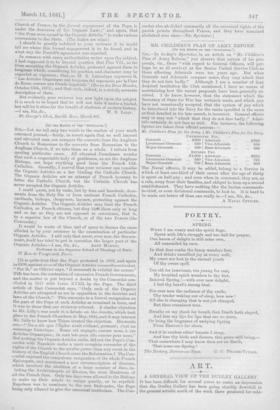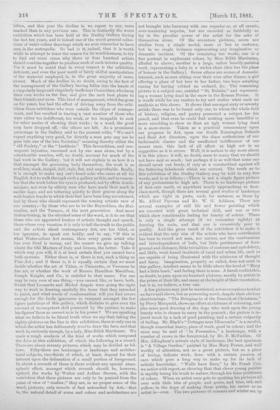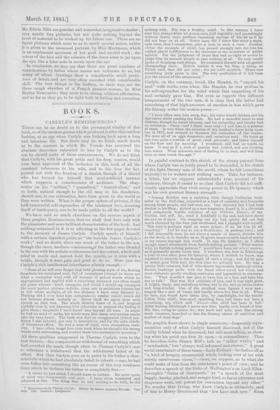ART.
A GENERAL VIEW OF THE DUDLEY GALLERY. IT has been difficult for several years to resist an impression that the Dudley Gallery has been going steadily downhill in the general artistic merit of the work there produced for exhi- bition, and this year the decline is, we regret to say, more marked than in any previous one. This is distinctly the worst exhibition which halt been held at the Dudley Gallery during the last ten years, and is indeed one of the worst general collec- tions of water-colour drawings which we ever remember to have seen in the metropolis. So bad is it, indeed, that it is worth while to attempt to trace the reason for its worthlessness, to try to find out some cause why three or four hundred artists 'should combine together to produce work of such inferior quality. For it must be noted that in every respect is the exhibition deficient, and even the poor merit of fairly skilful manipulation of the material employed, is, in the groat majority of cases, absent, Much of the decline is, no doubt, owing to the fact of the management of the Gallery having fallen into the hands of a singularly large and singularly inefficient Committee, who hang their own works on the line, and give the next best places to their friends, and so on. This kind, of management, which has gone on for years, has had the effect of driving away from the exhi- bition those exhibitors who were outside the clique of manage- ment, and has resulted in leaving a vast number of those who were either too indifferent, too weak, or too incapable to seek for other modes of showing their works ; in a word, the good men have dropped off,—the others are left. As a prominent personage in the Gallery said to the present critic, "We can't expect anything 'very good, for directly a man gets any use he goes into one of the two Societiee," meaning thereby either the "old Society," or the "Institute." This favouritism, and con- sequent injustice, exercised not by one man alone, but by a considerable number, will, no doubt, account for much of the bad work in the Gallery ; but it will not explain to us how it is that amongst the governing body themselves, the work is so soul-less, weak, insipid, dull, stale, fiat, and unprofitable. Really, it is enough to make any one's heart ache who cares at all for English Art to walk through such a gallery as this, and to remem- ber that the work before his eyes is produced, not by effete Acade- micians, not even by elderly men who have made their mark in earlier days, and are tottering quietly to their graves along the well-beaten tracks to which their feet have been long accustomed, but by those who should represent the coming artistic race of our cbuntry,—by those who are to be the Reynoldses, the Mul- readies, and the Turners, of the next generation. And more disheartening, in the strictest sense of the word, is it to see that those who are appointed leaders of artistic thought and. speech, those whose very vocation it is only to tell the truth to the public and the artists about contemporary Art, are too blind, or too ignorant, to speak out boldly, and to say, "If this is what Water-colour Art means, then every • great artist who has ever lived is wrong, and the sooner we give up talking about the Old Masters of Italy and Greece, the better. Take it which way you will, it is at least certain that you cannot have both systems. Either there is, or there is not, such a thing as Fine Art ; and if there is, it is equally certain that we must decide whether the art of Titian, or Tintoretto, or Veronese be fine art, or whether the work of Messrs. Hamilton Macallum, Joseph Knight,. and Co., is entitled to that name. For one may be very sure of one thing,—you cannot like, or have, both. Grant that Leonardo and Michel Angelo were going the right way to work in drawing carefully the faces that they intended to paint, and what words of condemnation will you find severe enough for the facile ignorance so rampant amongst the few figure paintings of this gallery, which disdains to give even the amount of incompetent skill possessed by the painter, to make his figures' faces as correct as is in his power ? We are speaking what we believe to he literal truth when we say that, taking the eighty pictures on the line in this exhibition, there is only one in which the artist he deliberately tried to draw the face, and that -work is, curiously enough, by a lady, Miss Edith Martineau. We made' a rough analysis of the kind of works which composed the Lice at this exhibition, of which the following is a record. There are about seventy pictures, which may be divided as fol- lows. Fifty-three are landscapes or landscape and architec- tural subjects, two-thirds of which, at least, depend for their interest upon the delineation of a small portion of foreground. In about a seventh of these is there evident any special atmo- spheric effect, amongst which seventh should be, however, noticed the works by 'Walter and Arthur Severn, with the restriction that these pictures are only to be praised from the point of view of "studies ;" they are, in no proper sense of the word, pictures, only records of fact untouched. by Art,—that is, the natural detail of scene and colour and architecture are not brought into harmony with one superior or, at all eventsr over-mastering impulse, but are recorded as faithfully as
lay in the peculiar power of the artist for the sake of themselves alone. Of the seventeen pictures, seven are studies from a single model, more or loss in costume, but in no single instance representing any imaginative or dramatic incident. Of the remaining ten works, one is a fine portrait in unpleasant colour, by Miss Edith Martineau, alluded to above; another is a large, rather heavily-paintea work, representing a baby in a wicker chair (this has the place of honour in the Gallery). Seven others are scenes of domestic.
interest, such as men sitting over their wine after dinner, a girl offering a glass of hot beer to her father, two boys awaiting caning for having robbed an orchard, (to. The remaining' picture is a subject one, entitled " St. Eulalia," and represent- ing a woman lying dead. in the snow in the Roman Forum. It is worth while for our readers to try and realise what such an analysis as this shows. It shows that amongst sixty or seventy artists there was to be found only one, to whom the whole field of history, religion, and poetry presented a subject for hie pencil, and that even he could find nothing more beautiful or more ennobling to show us than an ugly woman lying dead in a snow-storm. Taken as a practical commentary upon our progress in Art, upon our South Kensington Schoolls and their Art directors, upon the sham tnstheticism of our fashionable classes and the unaffected indifference of our poorer ones, this lack of all effort at high art is as suggestive as it is severe. Well, it is useless to say more about it in this place; it will, no doubt, seem to many that we should: not have said so much ; but perhaps it is as well that some one should speak out freely, if only as a counterblast against all the flattering falsehoods which are current. The truth as to this exhibition of the Dudley Gallery may be told in very few'
words, and is as follows :—There is not a single figure picture,
of any pretensions to high art. There is no landscape picture of first-rate merit, or anywhere nearly approaching to first-
class merit, though there are several good studies of landscape
which are right in parts, such, for instance, as those by Mr. Alfred Parsons and Mr. W. G-, Addison. There are
several examples of still life and flower painting which are executed with great technical skill, and one or two, which show considerable feeling for beauty of colour. There, is only a single attempt (if we remember rightly) at drawing the nude, and that one is excessively poor in quality. And the gross result of the exhibition is to make it evident that the only aim of the artists who have contributed.. has been to record not man, nor nature, nor the combination. and interdependence of both, but little prettinesses of fore- ground and distance, little trivialities of costume and upholstery,. and little, weak-kneed incidents of rural and urban life, such as. are capable of being illustrated with the minimum of thought and fancy. Imagination, properly so called, does not exist in this gallery, intellect seems to be little above the level of "Mary had a little lamb," and. feeling there is none. A harsh verdictthiss no doubt, to pass upon six hundred pictures, mostly by artists in the prime of their life, and many at the height of their reputation,. but it is, we believe, a true one.
A few pictures may just be mentioned, not as exceptions to what we have said above, but as possessing merit, despite their obvious shortcomings. "The Bringing-in of the Peacock at Christmas," by Percy Macquoid, shows an effort at richness of colouring, and, also some good drawing of the dogs who wait upon the young beauty who is chosen to carry in the peacock ; the picture is in- jured much by a lack of good. painting, and a certain vulgarity of feeling. Mr. Black's" Cottages near Ilfracombe" is a careful, though somewhat heavy, piece of work, good in colour ; and the same may be said of "In Possession," a landscape, with a number of crows in the foreground, by Mr. F. McFadden. Of Mrs. Allinghctm's minute style of landscape, the best epecinien, is "A Village Garden," painted by Miss Mary Foster, and. well worthy of attention, not as a great picture, but as a piece of loving, delicate work, done with a certain passion of care which goes a long way to make up for its lack of artistic knowledge. "Walls have Ears," by Mr. Frank Cox,. we notice with regret, as showing that that clever young painter • is rapidly losing his truth to nature, through his false prettiness of colour. When an artist once gets to spotting his pictures all over with little bits of purple, and green, and blue, red, and yellow, in the hope of making them pretty, his career as an artist is—over. The two pictures of summer and mister sea. by Mr. Edwin Ellis are genuine and somewhat imaginative studies ; very nearly fine pictures, but not quite getting beyond the level of material to be worked up for future use. There are no figure pictures which seem to us to Merit special notice, unlass it is given to the unnamed portrait by Miss Martineau, which is an unpleasant specimen of her good and careful work ; the colour of the face and the crimson of the dress seem to jar upon the eye, like a false note in music upon the car.
In conclusion, we may say that there are great numbers of contributions by ladies whose names arc unknown to us, but many of whose drawings show a considerable small pretti- ness of detail, and are very often executed with considerable skill. The best things in the Gallery, iu their way, are the three rough sketches of a French peasant-woman, by Miss Bertha Newcombe; they seem to be strong, without affectation, and as far as they go, to be right both in feeling and execution.




































 Previous page
Previous page